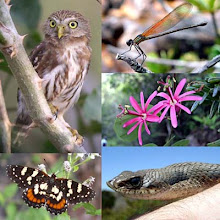June 17-21,
2015
From Bozeman
I flew to Redmond, Oregon, via Seattle. On the way from Seattle our pilot
banked the jet so those of us on the right side had this amazing view of Mount
St Helens.
I then had a
couple days to visit some friends in central Oregon. Wayne and I (his wife Patty,
my high school biology teacher, couldn’t make it) found three Blue-gray Gnatcatchers
on the north slope of Gray Butte in Jefferson County on an short excursion my
first afternoon. It wasn’t quite as rare as I thought it must be here, with
records dating back 20 years from this same area. The habitat looks right, with
scattered Western Junipers among a thicket of antelope bush and sagebrush that have
a chaparral-like structure.
This Mylitta
Crescent was one of the fiew butterflies we saw.
This is the
amazing view Wayne and Patty have of the Crooked River valley.
Wayne and I
also birded Hatfield Lake (the only sewage pond named after a congressman?),
where Eastern Kingbirds were a good find, plus many ducks and four Greater
Yellowlegs. I was later told that this was only the 11th record of
Eastern Kingbird for Deschutes County. Then my friend John and I made an
attempt for Boreal Owls above Todd Lake, departing at 2:00 a.m. on Friday. We heard
no owls, but it was a lovely night, and it was fun to hear the dawn chorus of
Hermit Thrush, Varied Thrush, Yellow-rumped Warbler, Dark-eyed Junco, and
Chipping Sparrow.
The views of
Mount Bachelor were stunning.
Back at the
parking lot Gray Jays appreciated the almonds I had brought along for my snack.
John and I
birded along the Deschutes River for most of the rest of the morning,
highlights being a family of Bufflehead, this Red-breasted Sapsucker…
… and this
surprising American Redstart, a second-year male.
Then came my
two days of leading field trips for the Dean Hale Woodpecker Festival, which
I’ve done for the past couple of years. In order to look for Black-backed and
American Three-toed Woodpeckers, we check burns, which often host several other species as well
In this burn
we found a pair of Black-backed Woodpeckers, and on the second day we returned
and found their nest.
At other
stops we had Williamson's Sapsucker, this one a juvenile male…
…White-headed
Woodpecker, an adult male…
…and Downy
Woodpecker, this one also a recently-fledged juvenile.
We didn’t
look at just woodpeckers – there were plenty of would-be lifers for the
participants among the other birds. This Hermit Warbler was new for some
people.
The most
unexpected bird on our first day was this very worn Red-shouldered Hawk, which
we first saw fly through the trees and disappear, but then found soaring high
overhead. It eventually became a small speck in the sky and drifted off to the
west.
Scenery and
wildflowers were abundant. This is Mount Washington, carved by many glaciers
during the last couple hundred thousand years.
This is Erythranthe lewisii, Lewis's
Monkeyflower. What used to be Mimulus
has been carved into a few genera based on genetic studies that agree with
older morphological data.
This is Platanthera dilatata var. dilatata, White Bog Orchid.






























































